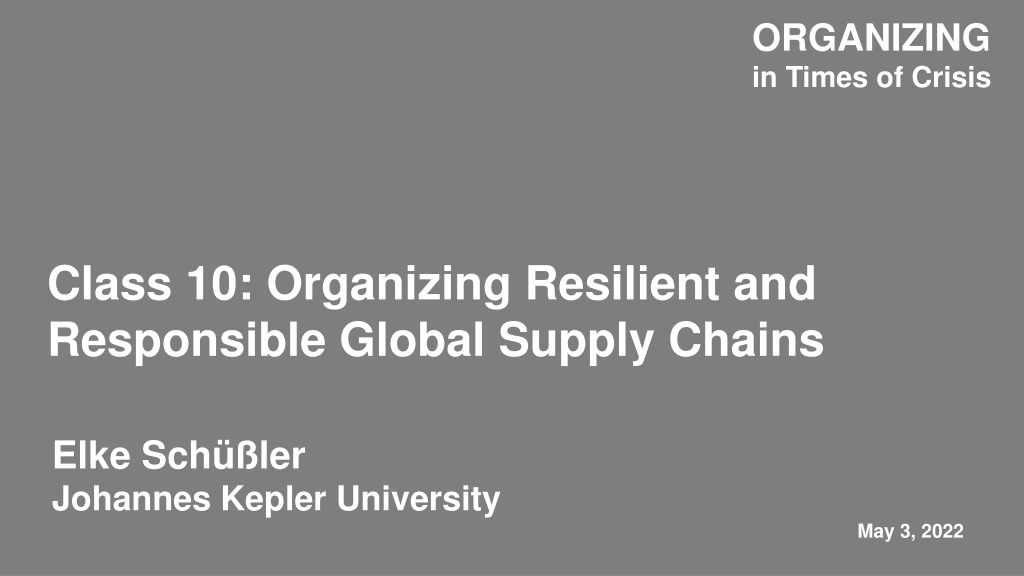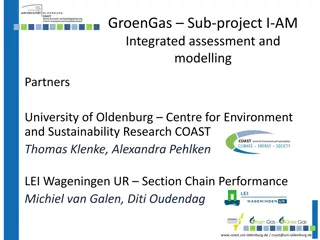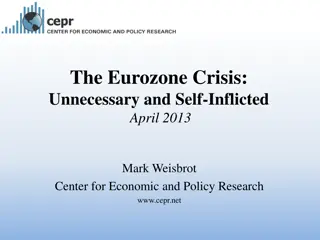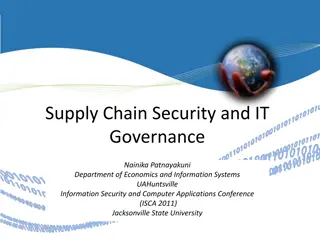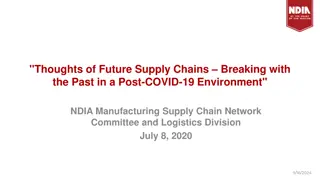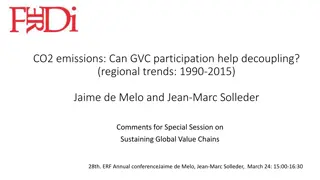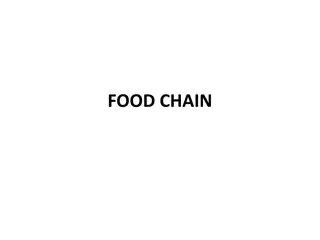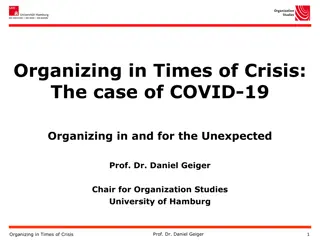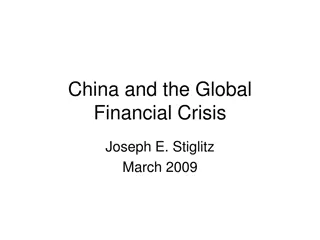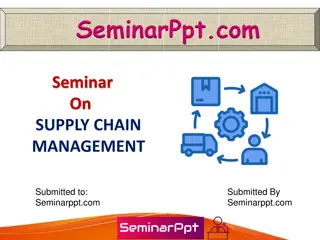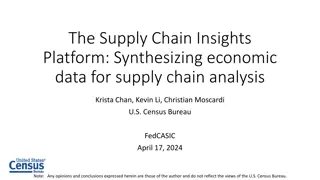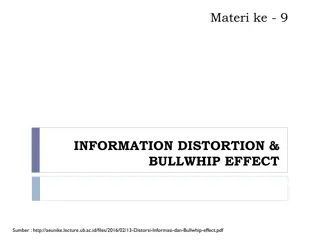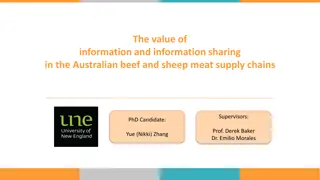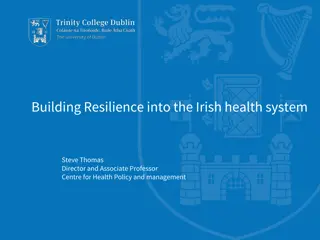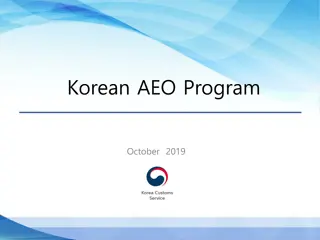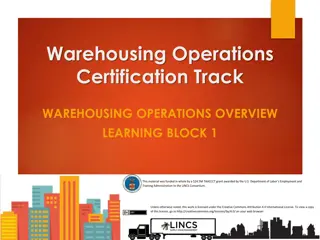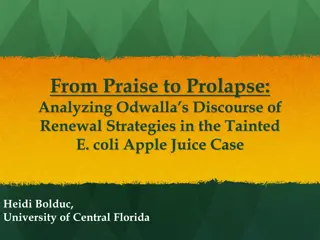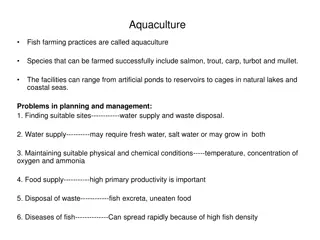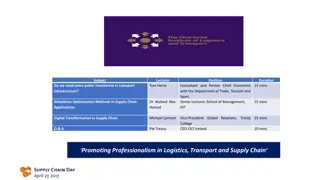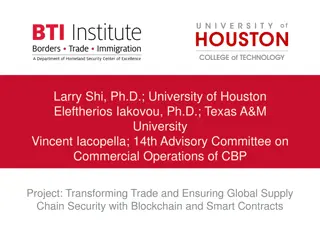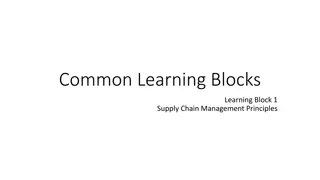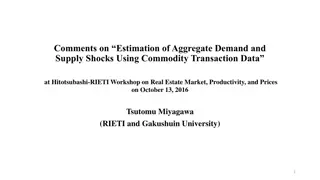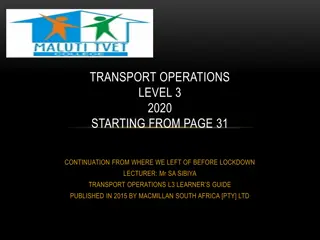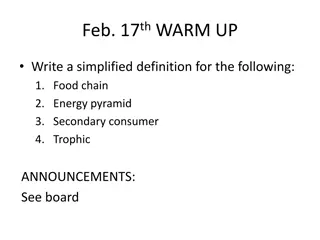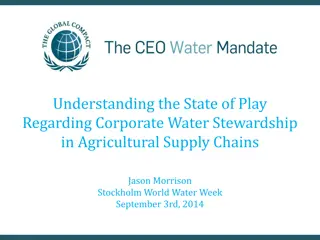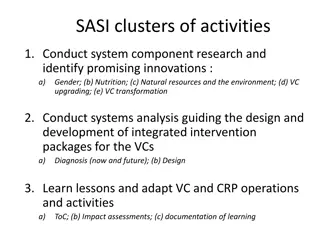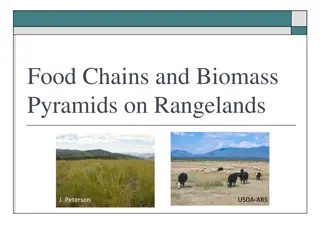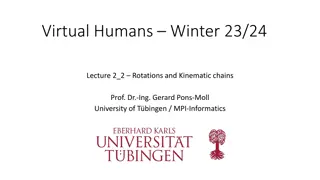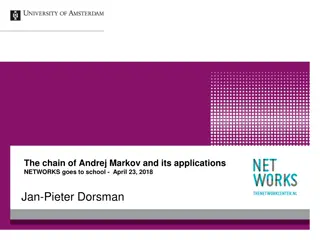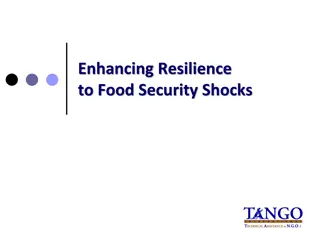Global Supply Chains and Resilience in Times of Crisis
Understanding the development and governance of global supply chains, exploring their vulnerabilities and responsible concerns, and mechanisms to enhance resilience and responsibility. Delve into the garment supply chain and the internationalization factors driving value chain fragmentation. Key concepts highlight the complexities and dynamics of global supply networks.
Download Presentation

Please find below an Image/Link to download the presentation.
The content on the website is provided AS IS for your information and personal use only. It may not be sold, licensed, or shared on other websites without obtaining consent from the author. Download presentation by click this link. If you encounter any issues during the download, it is possible that the publisher has removed the file from their server.
E N D
Presentation Transcript
ORGANIZING in Times of Crisis Class 10: Organizing Resilient and Responsible Global Supply Chains Elke Sch ler Johannes Kepler University May 3, 2022
New York Times Figure from: https://www2.deloitte.com/xe/en/insights/focus/supply-chain/supply-chain-war-russia-ukraine.html [2.5.2022]
LEARNING AIMS Understand how global supply chains for different goods and services have developed historically. Understand how global supply chains are organized and governed, making them prone to risks and responsibility concerns. Understand how by which governance mechanisms global supply chains can be made more resilient and responsible.
THE GARMENT SUPPLY CHAIN Designing and prototyping models Manufacture and assembly Buying materials Distribu- tion Retailing Marketing Planning collection Distribu- tion Designing and prototyping models Manufacture and assembly Buying materials Retailing Marketing Planning collection Full package/full service Distribu- tion Designing and prototyping models Manufacture and assembly Buying materials Retailing Marketing Planning collection New verticals Lane (2008), Sch ler (2009)
WHAT IS BEHIND INTERNATIONALIZATION AND FRAGMENTATION OF VALUE CHAINS? Motives Market access (export and labor) Efficiency considerations (cost cutting, focusing on core competences) Access to knowledge and expertise Escaping regulations and responsibility Main drivers Trade liberalization, esp. WTO TRIPS (Agreement on Trade Related Aspects of Intellectual Property Rights, 1994) and WTO membership of China (2001) Global competition spurring industry concentration and cost cutting Facilitator Information technology
KEY CONCEPTS Global supply chains, commodity chains, value chains, value networks, production networks common denominator: more than flows of goods Lead firms and suppliers, networkedinterorganizational relationships Buyer-driven vs producer-driven Governance: coordination, but also specific allocations of resources and distributions of gains market, modular, relational, captive, hierarchy Inequality and upgrading Gereffi (1999), Gereffi et al. (2005)
COMPLEXITY 1: PLURAL FORMS Schematic picture of garment industry global value networks Helfen et al. (2018)
COMPLEXITY 2: REGULATORY GAP No world government and multiple collective action problems between firms, between suppliers and between nations Legal complexity legal vs moral responsibility boundaries; which jurisdiction should be applied? International regulations such as the OECD s corporate responsibility guidelines typically non-binding Multinational Enterprises (MNEs) are called upon as political actors but face weak long-term incentives to act responsibly e.g. Scherer & Palazzo (2011)
COMPLEXITY 3: VUCA DISRUPTIVE EVENTS Image source: Wikimedia commons
DIFFERENT AVENUES FOR MANAGING COMPLEXITIES Via network management (corporate-driven path) Via private, multi-stakeholder regulation Via public regulation
BASIC MODES OF REGULATION Hard law (public) State, industry associations, trade unions Soft law (private) Companies, NGOs, civil society, trade unions Actors Mechanisms Law, sanctions Incentives, information, moral appeals Mode Authority-oriented Market-oriented Examples Loi de Vigilance; Brussels 1 regulation; national civil laws UN Guiding Principles on Business and Human Rights; UN Global Compact Own depiction; based on Hassel (2008)
PRIVATE, MULTI-STAKEHOLDER REGULATION Multiple Firms Multi-Firm Transnational Industrial Relations Initiatives Labor- Industry-Led Initiatives Inclusive MSIs (e.g. ETI) II IV Protocol Agreements Inclusive of Unions Exclusive of Unions I III Brand-Union Agreements (e.g. GFAs) Codes of Conduct Single Firms Ashwin et al. (2020)
NETWORK MANAGEMENT FOR RESILIENCE AND RESPONSIBILITY e.g. reducing the number of subcontractors; using health & safety as well as quality labor-standards as criteria in selection procedures Reputation, customer expectations, union influence, regulation Field level Network dynamics, relational advantage GVN management practices selecting, allocating, regulating, evaluating Plural GVN governance structures market, modular, relational, captive, hierarchical Network level Multi-employer relations in GVN Network responsibility e.g. evaluating network reliability and assessing network risks in supply chain due diligence Network participation and contribution, firm-level advantage Organizational structure, culture, HRM Helfen et al. (2018); Sydow et al. (2016; 2021)
PUBLIC REGULATION E.G. GERMAN LAW ON SUPPLY CHAIN DUE DILIGENCE Passing of the law on 11.6.21 after a long negotiation process (entry into force: January 1st 2023) German MNCs have to guarantee human rights and environmental standards in their supply chains and will be fined in case of violations No civil right liability; NGOs or unions can file legal action on behalf of affected individuals Initially (from 2023 on) only for companies > 3000 employees ~ 600 MNCs. From 2024 on > 1000 employees ~ 2.891 MNCs (BMAS) A government agency controls compliance with legislation; sanctions through public procurement bans Krajewski et al. (2021)
FROM RISK TO RESILIENCE AND RESPONSIBILITY Mixing make, buy and cooperate on a whole network level to allow for lose coupling, diversity, redundancy Developing fair purchasing practices Using new technologies, e.g. additive manufacturing Strengthening global governance, collective action and binding agreements Sharing responsibility in industry-specific MSIs Developing regenerative strategies Fine-grained supply chain structures Resource dependence increased through supplier consolidation Outsourcing spirals and competency traps Lean supply chains Systemic inequalities Weak regulation Anner (2021); Baumann-Pauly et al. (2017); Frenkel & Sch ler (2021); Hahn & Tampe (2021); Phillips et al. (2022) 15
SUMMARY States have a key role to play in setting the rules of the game of the global economy supply chains are political arenas The current structure of global supply chains bears several risks for lead firms, suppliers, workers and consumers, and risks are unequally distributed Resilience and responsibility can be gained from taking a whole networks perspective on managing supply chains, involving stakeholders and developing industry-specific, collective agreements Companies have already re-evaluated their supply chains during the pandemic and will likely continue to do so
CONTACT Prof. Dr. Elke Sch ler Professor of Business Administration Institute of Organization Science Johannes Kepler University Linz Mail: elke.schuessler@jku.at Web: www.jku.at/org Twitter: @ElkeSchuessler and @OS4Future 17
REFERENCES (1/2) Anner, M. (2021). Three labour governance mechanisms for addressing decent work deficits in global value chains. International Labour Review, 160(4), 611-629. Ashwin, S., Oka, C., Sch ler, E., Alexander, R., & Lohmeyer, N. (2020). Spillover effects across transnational industrial relations agreements: The potential and limits of collective action in global supply chains. ILR Review. In print. Baumann-Pauly, D., Nolan, J., Van Heerden, A., & Samway, M. (2017). Industry-specific multi-stakeholder initiatives that govern corporate human rights standards: Legitimacy assessments of the Fair Labor Association and the Global Network Initiative. Journal of Business Ethics, 143(4), 771-787. Frenkel, S. J., & Schuessler, E. S. (2021). From Rana Plaza to COVID 19: Deficiencies and opportunities for a new labour governance system in garment global supply chains. International Labour Review, 160(4), 591-609. Gereffi, G., Humphrey, J., & Sturgeon, T. (2005). The governance of global value chains. Review of International Political Economy, 12(1), 78-104. Gereffi, G. (1999). A commodity chains framework for analyzing global industries. Institute of Development Studies, 8(12), 1-9. Hahn, T., & Tampe, M. (2021). Strategies for regenerative business. Strategic Organization, 19(3), 456-477. Hassel, A. (2008). The evolution of a global labor governance regime. Governance, 21(2), 231-251.
REFERENCES (2/2) Helfen, M., Sch ler, E., & Sydow, J. (2018). How can employment relations in global value networks be managed towards social responsibility?. Human Relations, 71(12), 1640-1665. Lane, C. (2008). National capitalisms and global production networks: An analysis of their interaction in two global industries. Socio-Economic Review, 6(2), 227-260. Phillips, W., Roehrich, J. K., Kapletia, D., & Alexander, E. (2021). Global value chain reconfiguration and COVID-19: Investigating the case for more resilient redistributed models of production. California Management Review, in print. Scherer, A. G., & Palazzo, G. (2011). The new political role of business in a globalized world: A review of a new perspective on CSR and its implications for the firm, governance, and democracy. Journal of Management Studies, 48(4), 899-931. Sch ler, E. (2009). Strategische Prozesse und Persistenzen: Pfadabh ngige Organisation der Wertsch pfung in der Bekleidungsindustrie. Kohlhammer. Sydow, J., Sch ler, E., & Helfen, M. (2022). Managing global production networks: Towards social responsibility via inter- organizational reliability? In: Biggiero, L. et al. (eds.) The Relational View of Economics (pp. 133-158). Springer, Cham. Sydow, J., Sch ler, E., & M ller-Seitz, G. (2016). Managing Inter-Organizational Relations: Debates and Cases. Macmillan International Higher Education.
